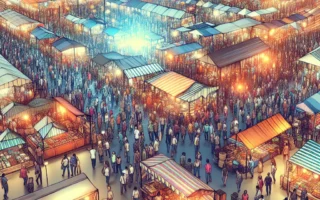The Role of Fairs in Boosting Local Economies
The Role of Fairs in Boosting Local Economies
Local fairs play a crucial role in boosting the economies of the communities in which they are held. These events provide a significant economic impact by attracting both local residents and visitors from neighboring areas. The economic benefits of fairs are multifaceted, ranging from increased spending in local businesses to job creation and infrastructure development.
One of the primary ways in which fairs contribute to the local economy is through the influx of visitors. As individuals from outside the community attend the fair, they often spend money on accommodations, dining, and shopping in the surrounding area. This increased tourist spending provides a direct stimulus to local businesses, including hotels, restaurants, and retail establishments. In addition, the higher demand for goods and services during the fair can lead to an increase in employment opportunities as businesses strive to meet the needs of the influx of visitors.
Furthermore, local fairs can serve as a platform for small businesses and artisans to showcase and sell their products. This can result in a boost to the local economy by supporting entrepreneurship and providing a venue for local entrepreneurs to connect with potential customers. As a result, the fair can act as a catalyst for the growth of the local entrepreneurial ecosystem.
The economic impact of fairs also extends to the improvement of local infrastructure and public services. Revenue generated from the fair, such as entrance fees and vendor fees, can contribute to the development and maintenance of community facilities and services. This can include investments in parks, transportation, and public safety, all of which enhance the overall quality of life for residents.
In conclusion, local fairs play a significant role in boosting the economies of the communities they serve. By attracting visitors, supporting local businesses, and contributing to infrastructure development, fairs have a tangible economic impact that extends well beyond the duration of the event itself.
Keywords: local fairs, economic impact, local economies, community development, small businesses, tourism, infrastructure, entrepreneurship, economic stimulus
Analyzing the Financial Impact of Fairs on Small Businesses
Analyzing the financial impact of fairs on small businesses is crucial for understanding the economic benefits that these events bring to local communities. Fairs provide small businesses with an excellent opportunity to showcase their products and services to a large and diverse audience. This exposure can result in increased sales and heightened brand visibility for these businesses.
Furthermore, fairs often serve as a catalyst for economic activity in the surrounding areas. Local businesses such as restaurants, hotels, and transportation services often experience a surge in demand during fair periods, leading to increased revenue and job opportunities. This symbiotic relationship between fairs and small businesses exemplifies the mutually beneficial nature of these events.
In addition to direct financial gains, participating in fairs can also offer small businesses the chance to network with other enterprises, forge new partnerships, and gain valuable customer feedback. These interactions can have long-term positive effects on the development and growth of small businesses, contributing to the overall economic vitality of the community.
Understanding the financial impact of fairs on small businesses is essential for local authorities and event organizers to recognize the significant role that fairs play in stimulating economic growth and fostering a thriving business environment.
Job Creation and Revenue Generation: Fairs’ Contribution to Local Communities
Fairs play a significant role in contributing to the economic development of local communities by creating job opportunities and generating revenue. The influx of visitors during fair events leads to an increased demand for services, resulting in job creation across various sectors such as hospitality, transportation, and retail. Local businesses often experience a surge in sales during fair periods, further boosting employment opportunities as they expand their workforce to meet the heightened demand.
Moreover, fairs have a direct impact on revenue generation within local communities. The substantial footfall of attendees translates to increased spending on accommodations, dining, and recreational activities, thereby stimulating the local economy. Additionally, fairs often collaborate with local suppliers and vendors for goods and services, fostering business partnerships and contributing to the overall revenue circulation within the community.
Overall, the role of fairs in job creation and revenue generation within local communities cannot be overstated. As magnets for tourism and economic activity, fairs act as catalysts for growth, benefiting the community at large.
Exploring the Ripple Effects of Fair-Related Spending
When examining the economic impact of fairs on local communities, it is crucial to explore the ripple effects of fair-related spending. The direct expenditure associated with fairs, including ticket sales, vendor fees, and food and beverage purchases, undoubtedly injects money directly into the local economy. However, the broader impact of this spending extends far beyond the fairgrounds. Local businesses, such as hotels, restaurants, and retail establishments, often experience increased sales during fair periods due to the influx of fair attendees.
Furthermore, the employment opportunities generated by fairs contribute to the local economy by providing temporary jobs for individuals in the community. This, in turn, leads to additional spending on goods and services, creating a cycle of economic stimulation. Moreover, the visibility and attraction of fairs can result in enhanced tourism, drawing visitors to the area who may continue to support local businesses long after the fair has concluded.
It is important to recognize that the economic benefits of fairs extend well beyond the immediate revenue generated within the fairgrounds. By examining the ripple effects of fair-related spending, we gain a comprehensive understanding of how fairs contribute to the economic vitality of local communities.
Community Development and Social Benefits of Fairs
Fairs play a significant role in the economic and social development of local communities. They provide a platform for small businesses and artisans to showcase their products, thereby contributing to the local economy. Additionally, fairs attract a wide range of visitors, leading to increased foot traffic in the area and benefiting local businesses such as hotels, restaurants, and transportation services.
Furthermore, fairs promote community engagement and social interaction. They often serve as a gathering point for residents, fostering a sense of unity and pride in the local culture and traditions. Additionally, fairs frequently feature entertainment and educational activities that appeal to families and individuals of all ages, thus enriching the social fabric of the community.
Moreover, the social benefits of fairs extend to the promotion of cultural exchange and understanding. Many fairs showcase traditional crafts, music, and cuisine, offering visitors the opportunity to experience diverse cultural heritage. This can lead to greater appreciation and respect for different cultural backgrounds, contributing to the overall social harmony within the community.
In conclusion, fairs have a multifaceted impact on local communities, driving economic growth, fostering social cohesion, and promoting cultural diversity. By providing a platform for businesses, encouraging social interactions, and celebrating cultural heritage, fairs play a vital role in the overall development and well-being of localities.
Sustainable Economic Growth through Fair Participation
Sustainable economic growth through fair participation is a crucial aspect that plays a significant role in the overall economic impact of fairs on local communities. Fairs provide a platform for local businesses and artisans to showcase their products and services, thus stimulating economic activity. By participating in fairs, these businesses can expand their customer base, increase sales, and contribute to the local economy.
Furthermore, fairs can also attract tourists and visitors from neighboring areas, leading to a boost in the hospitality and tourism sectors. This influx of visitors not only generates revenue for local businesses but also creates job opportunities, further contributing to sustainable economic growth. Additionally, the exposure to new markets and consumer feedback gained through fair participation can help businesses innovate and improve their offerings, enhancing their long-term sustainability.
Moreover, fairs often integrate educational components and workshops focused on sustainability, environmental conservation, and ethical business practices. This emphasis on sustainability can influence both businesses and consumers, leading to the adoption of sustainable practices that benefit the local community and the environment.
In conclusion, the participation of local businesses and the integration of sustainability-focused initiatives in fairs can have a profound impact on the economic growth of local communities. By facilitating business expansion, creating employment opportunities, and promoting sustainable practices, fairs play a pivotal role in fostering sustainable economic development.



